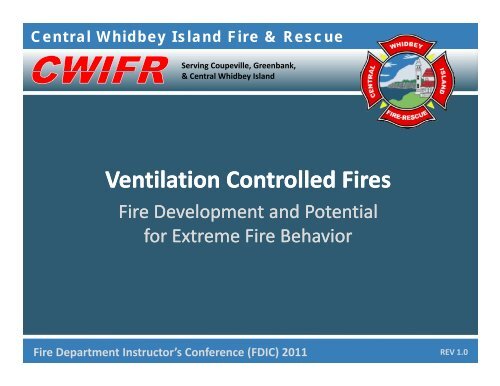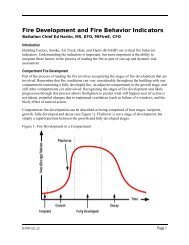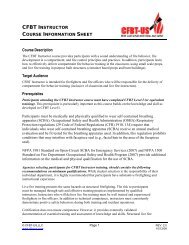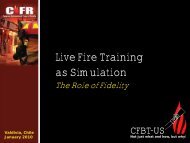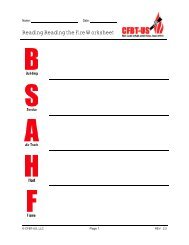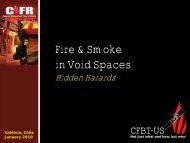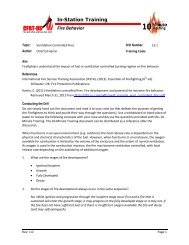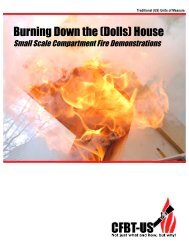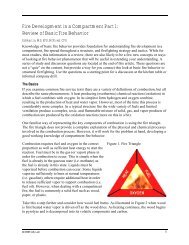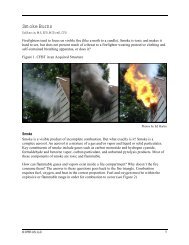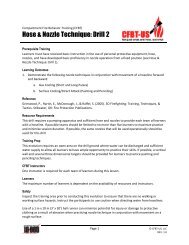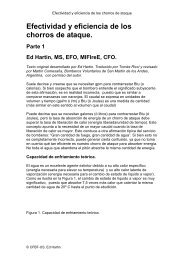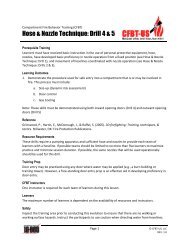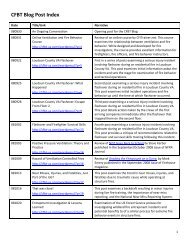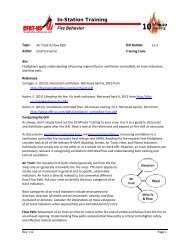Ventilation Controlled Fires - CFBT-US!
Ventilation Controlled Fires - CFBT-US!
Ventilation Controlled Fires - CFBT-US!
Create successful ePaper yourself
Turn your PDF publications into a flip-book with our unique Google optimized e-Paper software.
Central Whidbey Island Fire & Rescue<br />
Serving Coupeville, Greenbank,<br />
& Central Whidbey Island<br />
<strong>Ventilation</strong> <strong>Controlled</strong> <strong>Fires</strong><br />
Fire Development Development and Potential<br />
for Extreme Fire Behavior<br />
Central Fire Department Whidbey Island Fire Instructor’s & Rescue Conference Professionalism (FDIC) ● Integrity 2011<br />
● Compassion ● Excellence REV 1.0
Central Whidbey Island Fire & Rescue<br />
� Whidbey is a large island in the Puget<br />
SSound d(N (Northwest h Washington)<br />
W hi )<br />
� CWIFR is a combination department<br />
serving 50 mi2 (129 km 2 ) from four fire<br />
stations<br />
� Predominant fire risks in this rural district<br />
are private dwellings and small to mid mid‐size size<br />
commercial occupancies<br />
Central Whidbey Island Fire & Rescue Professionalism ● Integrity ● Compassion ● Excellence<br />
REV 1.0
Philosophy<br />
In order to carry on your business properly, it is<br />
necessary for those who practice it to understand<br />
not only what they have to do, but why they have<br />
to do it…<br />
No fireman can ever be considered to have<br />
attained a real proficiency in his business until he<br />
h has thoroughly th hl mastered t d this thi combination bi ti of f<br />
theory and practice.<br />
Fire Protection, 1876<br />
Sir Eyre Massey Shaw<br />
Chief Chief, London Fire Brigade<br />
Central Whidbey Island Fire & Rescue Professionalism ● Integrity ● Compassion ● Excellence<br />
REV 1.0
Overview<br />
� Compartment <strong>Fires</strong><br />
� Fire Development<br />
�� Burning Regime<br />
� Vent <strong>Controlled</strong> <strong>Fires</strong><br />
�� Et Extreme Fire Fi Behavior Bh i<br />
� UL Tactical Considerations<br />
� Practical Applications<br />
Central Whidbey Island Fire & Rescue Professionalism ● Integrity ● Compassion ● Excellence<br />
REV 1.0
Compartment Fire<br />
The term compartment fire is<br />
also used for fires involving g<br />
multiple compartments<br />
A compartment is an<br />
enclosure such as a<br />
room within a building<br />
Central Whidbey Island Fire & Rescue Professionalism ● Integrity ● Compassion ● Excellence<br />
REV 1.0
Building Factors Area<br />
Structural<br />
Non<br />
Structural<br />
Thermal<br />
Properties p<br />
Type<br />
Fuel<br />
Construction<br />
Mass<br />
Fire<br />
Protection<br />
Systems<br />
Fire<br />
Load<br />
Contents<br />
Required<br />
Fire Flow<br />
Building<br />
HVAC<br />
Size<br />
Compartmentation<br />
Height<br />
<strong>Ventilation</strong><br />
Profile<br />
Normal<br />
<strong>Ventilation</strong><br />
Stories<br />
Ceiling<br />
Openings<br />
Actual Potential<br />
Central Whidbey Island Fire & Rescue Professionalism ● Integrity ● Compassion ● Excellence<br />
REV 1.0 0.1
Fire Load<br />
The mass and burning<br />
characteristics of the fuel<br />
encountered in compartment<br />
fires has changed over time.<br />
Low<br />
High<br />
Fuel Load<br />
1942 1980<br />
9.9 kg/m 2<br />
64.4 kg/m 2<br />
29.3 kg/m 2<br />
125.5 kg/m 2<br />
MJ/kg<br />
40<br />
30<br />
20<br />
10<br />
Wood Polystyrene<br />
Polyurethane<br />
Foam<br />
Central Whidbey Island Fire & Rescue Professionalism ● Integrity ● Compassion ● Excellence<br />
Polyethylene<br />
REV 1.0
Compartmentation<br />
� Fire develops more<br />
quickly in a small<br />
compartment.<br />
�� Highly compartmented<br />
buildings may slow fire<br />
spread. p<br />
� Large compartments<br />
contain more air and<br />
may have a substantial<br />
fuel load.<br />
Central Whidbey Island Fire & Rescue Professionalism ● Integrity ● Compassion ● Excellence<br />
REV 1.0
<strong>Ventilation</strong> Profile<br />
Existing and Potential Openings<br />
� Normal building ventilation and<br />
compartmentation<br />
� <strong>Ventilation</strong> l openings created d bby<br />
exiting civilian occupants<br />
� Tactical action taken by y<br />
firefighters<br />
� Unplanned ventilation<br />
All changes to the ventilation profile<br />
may influence fire behavior!<br />
Central Whidbey Island Fire & Rescue Professionalism ● Integrity ● Compassion ● Excellence<br />
REV 1.0
Basic Considerations<br />
� Under given conditions,<br />
compartment fires<br />
behave consistently<br />
� Staffing has no impact<br />
on fi fire dynamics d i<br />
� Context is critical!<br />
Central Whidbey Island Fire & Rescue Professionalism ● Integrity ● Compassion ● Excellence<br />
REV 1.0
Basic Considerations<br />
� Fuel Characteristics<br />
� Compartmentation i<br />
�� <strong>Ventilation</strong> Profile<br />
Firefighters have two primary strategies to<br />
influence fire behavior (fire control & ventilation)<br />
Central Whidbey Island Fire & Rescue Professionalism ● Integrity ● Compassion ● Excellence<br />
REV 1.0
Fire Dynamics<br />
NIOSH F2010‐10 F2010 10 � Ensure that the incident<br />
FF/EMT‐P Brian Carey (Fatality)<br />
FF/EMT‐P Kara Kopas (Injured)<br />
� Ensure that the incident<br />
commander and firefighters<br />
understand the influence of<br />
ventilation on fire behavior<br />
�� Consider developing more<br />
comprehensive training<br />
requirements q for fire behavior<br />
in NFPA 1001 and NFPA 1021.<br />
Central Whidbey Island Fire & Rescue Professionalism ● Integrity ● Compassion ● Excellence<br />
REV 1.0
Building Blocks for Understanding<br />
� Stages of Development<br />
� Incipient<br />
� Growth<br />
� Fully Developed<br />
� Decay<br />
� Heat Release l Rate (HRR) ( )<br />
� Burning Regime<br />
� Fuel <strong>Controlled</strong><br />
� <strong>Ventilation</strong> <strong>Controlled</strong><br />
Central Whidbey Island Fire & Rescue Professionalism ● Integrity ● Compassion ● Excellence<br />
REV 1.0
Stages of Fire Development<br />
HRR<br />
Incipient<br />
Growth<br />
Fully<br />
Developed Decay<br />
Central Whidbey Island Fire & Rescue Professionalism ● Integrity ● Compassion ● Excellence<br />
Time<br />
REV 1.0
Stages of Fire Development<br />
�� Th The stages t ddescribe ib a<br />
complex process.<br />
� Multiple influencing<br />
variables are involved.<br />
� Fire development can vary<br />
from this simple p sequence q<br />
Central Whidbey Island Fire & Rescue Professionalism ● Integrity ● Compassion ● Excellence<br />
REV 1.0
Central Whidbey Island Fire & Rescue Professionalism ● Integrity ● Compassion ● Excellence<br />
REV 1.0
Burning Regimes<br />
�� Fuel <strong>Controlled</strong><br />
Fire growth is predominantly<br />
limited by the fuel availability<br />
and characteristics<br />
� <strong>Ventilation</strong> il i <strong>Controlled</strong> C ll d<br />
Fire growth is predominantly<br />
li limited i d bby available il bl oxygen<br />
Central Whidbey Island Fire & Rescue Professionalism ● Integrity ● Compassion ● Excellence<br />
REV 1.0
Fuel and Power Key Concepts<br />
� The chemical content of fuel influences heat of<br />
combustion and heat release rate (HRR) (HRR).<br />
� Heat of combustion is the total amount of energy<br />
released when a specific amount of fuel is oxidized.<br />
Central Whidbey Island Fire & Rescue Professionalism ● Integrity ● Compassion ● Excellence<br />
REV 1.0
Fuel and Power Key Concepts<br />
� Power is an amount of energy<br />
delivered over a specified time<br />
�� Heat release rate (HRR) is the<br />
energy release per unit of time.<br />
Energy<br />
Power<br />
Units of Measure<br />
Joules (J)<br />
Watts (J/s)<br />
Btu<br />
Btu/s<br />
Central Whidbey Island Fire & Rescue Professionalism ● Integrity ● Compassion ● Excellence<br />
REV 1.0
Heat Release and Oxygen Key Concepts<br />
Oxygen Consumption<br />
� 13.7 MJ/kg of O 2<br />
�� 21% O 2 iin Ai Air<br />
� 3.00 MJ/kg of Dry Air<br />
� 3.60 MJ/m 3 of Dry Air<br />
William Thornton (1917)<br />
The Relation of Oxygen to the Heat<br />
of Combustion of Organic Compounds<br />
Central Whidbey Island Fire & Rescue Professionalism ● Integrity ● Compassion ● Excellence<br />
REV 1.0
Heat Release and Oxygen Key Concepts<br />
The door should be kept shut<br />
while the water is being brought,<br />
and the air excluded as much as<br />
possible, as the fire burns<br />
exactly in proportion to the<br />
quantity of air which it receives.<br />
James Braidwood (1866)<br />
Fire Prevention and Fire Extinction<br />
Central Whidbey Island Fire & Rescue Professionalism ● Integrity ● Compassion ● Excellence<br />
REV 1.0
Heat Release Rate Key Concepts<br />
�� Heat release rate (HRR) is the<br />
driving force for the fire.<br />
�� Room temperature and<br />
concentration of toxic<br />
combustion products p are<br />
correlated with HRR.<br />
�� High g HRR indicates a high g<br />
threat to life.<br />
Central Whidbey Island Fire & Rescue Professionalism ● Integrity ● Compassion ● Excellence<br />
REV 1.0
Heat Release Rate Key Concepts<br />
HRR varies over time, increasing as<br />
more fuel becomes involved and then<br />
falling as fuel is consumed.<br />
HRR (kW)<br />
kW<br />
Time (s) ( )<br />
Central Whidbey Island Fire & Rescue Professionalism ● Integrity ● Compassion ● Excellence<br />
REV 1.0
Visualization<br />
Visualize packages of<br />
fuel materials in terms<br />
of heat of combustion<br />
and potential p ppeak<br />
HRR<br />
Wood and Polyurethane Sofa<br />
51.3 kg (113 lbs)<br />
770 MJ Heat Release<br />
300MW 3.00 MW Peak HRR<br />
Central Whidbey Island Fire & Rescue Professionalism ● Integrity ● Compassion ● Excellence<br />
REV 1.0
Visualization<br />
HRR<br />
(kW)<br />
4000<br />
3000<br />
2000<br />
1000<br />
0<br />
0 300 600<br />
Time (s)<br />
http://www.fire.nist.gov/fire/fires/fires.html<br />
Central Whidbey Island Fire & Rescue Professionalism ● Integrity ● Compassion ● Excellence<br />
REV 1.0
Incomplete Combustion<br />
What happens if the fuel is<br />
not completely oxidized<br />
during combustion?<br />
Incomplete combustion results in production of carbon<br />
monoxide, carbon particulate and a wide range of<br />
other substances (depending on the fuel) as well as<br />
accumulation of unburned pyrolysis products.<br />
Central Whidbey Island Fire & Rescue Professionalism ● Integrity ● Compassion ● Excellence<br />
REV 1.0
What is Smoke<br />
� Product of incomplete Smoke is Fuel!<br />
combustion & pyrolysis<br />
� Complex p aerosol (g (gas, vapor, p<br />
particulate)<br />
� Toxic and flammable<br />
� Fluid that can transfer energy<br />
(convection (co ect o aand dradiation) ad at o )<br />
Central Whidbey Island Fire & Rescue Professionalism ● Integrity ● Compassion ● Excellence<br />
REV 1.0
Upper Layer Hazards<br />
� As a fire grows hot smoke<br />
forms a layer above the<br />
cooler air below.<br />
�� Thi This upper layer l presents t<br />
several hazards.<br />
� RRadiant di tand d Convective C ti<br />
Heat Flux<br />
�� Readily ignitable gas<br />
phase fuel<br />
Smoke is Fuel<br />
Central Whidbey Island Fire & Rescue Professionalism ● Integrity ● Compassion ● Excellence<br />
REV 1.0
Contemporary Fire Development<br />
HRR<br />
Fuel<br />
<strong>Controlled</strong><br />
<strong>Ventilation</strong><br />
<strong>Controlled</strong><br />
<strong>Ventilation</strong> Increased<br />
Time<br />
Central Whidbey Island Fire & Rescue Professionalism ● Integrity ● Compassion ● Excellence<br />
REV 1.0
Central Whidbey Island Fire & Rescue Professionalism ● Integrity ● Compassion ● Excellence<br />
REV 1.0
Extreme Fire Behavior Phenomena<br />
�� Flashover<br />
� Backdraft<br />
� Smoke Explosion<br />
� Flash Fire<br />
Firefighters may be able to define these<br />
terms, but often miss key indicators of<br />
potential extreme fire behavior!<br />
Central Whidbey Island Fire & Rescue Professionalism ● Integrity ● Compassion ● Excellence<br />
REV 1.0
Extreme Fire Behavior<br />
Rapid transition and<br />
sustained increase in HRR<br />
Ignition and rapid or<br />
explosive combustion<br />
Step Events<br />
Fuel <strong>Ventilation</strong><br />
<strong>Controlled</strong> <strong>Controlled</strong><br />
Flashover<br />
Vent‐Induced<br />
Moderate Fuel/Air<br />
Concentration<br />
Flashover<br />
HRR Sufficient to Result in Full Surface<br />
Involvement<br />
Phenomena that result in rapid<br />
fire progression and present a<br />
significant threat to firefighters<br />
Smoke<br />
Explosion<br />
Pre‐Mixed<br />
Flammable<br />
Fuel/Air Concentration<br />
Transient Events<br />
Overpressure<br />
Confined<br />
Flash<br />
Fire<br />
BBackdraft kd ft<br />
High Fuel/Air<br />
Concentration<br />
Pre‐Mixed Flammable<br />
Fuel/Air Concentration<br />
Limited Mass or Confinement<br />
Minimal<br />
Overpressure<br />
Central Whidbey Island Fire & Rescue Professionalism ● Integrity ● Compassion ● Excellence<br />
REV 1.0
Extreme Fire Behavior Step Event<br />
HRR<br />
Fuel<br />
<strong>Controlled</strong><br />
<strong>Ventilation</strong><br />
<strong>Controlled</strong><br />
<strong>Ventilation</strong> Increased<br />
Time<br />
Central Whidbey Island Fire & Rescue Professionalism ● Integrity ● Compassion ● Excellence<br />
REV 1.0
Extreme Fire Behavior Transient Event<br />
HRR<br />
Fuel<br />
<strong>Controlled</strong><br />
<strong>Ventilation</strong><br />
<strong>Controlled</strong><br />
<strong>Ventilation</strong> Increased<br />
Time<br />
Central Whidbey Island Fire & Rescue Professionalism ● Integrity ● Compassion ● Excellence<br />
REV 1.0
Extreme Fire Behavior Ambiguous Events<br />
HRR<br />
Fuel<br />
<strong>Controlled</strong><br />
<strong>Ventilation</strong><br />
<strong>Controlled</strong><br />
<strong>Ventilation</strong> Increased<br />
Time<br />
What is This?<br />
Central Whidbey Island Fire & Rescue Professionalism ● Integrity ● Compassion ● Excellence<br />
REV 1.0
Experience<br />
� Washington DC ‐ Flashover<br />
� New York City ‐ Backdraft<br />
�� Duango CO ‐ Smoke Explosion<br />
� San Pablo CA ‐ Flash Fire<br />
<strong>CFBT</strong>‐<strong>US</strong>, LLC has developed case studies<br />
for each of these incidents. The cases<br />
can be downloaded at www.cfbt‐us.com<br />
Central Whidbey Island Fire & Rescue Professionalism ● Integrity ● Compassion ● Excellence<br />
REV 1.0
Washington DC Flashover<br />
May 30, 1999<br />
3146 Cherry Road NE<br />
Side A<br />
Firefighter Anthony Phillips<br />
Firefighter i fi h Lewis i Mathews<br />
h<br />
Central Whidbey Island Fire & Rescue Professionalism ● Integrity ● Compassion ● Excellence<br />
Side C<br />
REV 1.0
New York NY Backdraft<br />
March 28, 1994<br />
62 Watts Street<br />
Captain John Drennan<br />
Firefighter James Young<br />
Firefighter Christopher Seidenburg<br />
June 17, 2001<br />
12‐22 Astoria Boulevard<br />
Firefighter John J. Downing<br />
Firefighter Brian D. Fahey<br />
Firefighter Harry S. Ford<br />
Central Whidbey Island Fire & Rescue Professionalism ● Integrity ● Compassion ● Excellence<br />
REV 1.0
Durango CO Smoke Explosion<br />
January 22, 2008<br />
764 Main Street<br />
Nine Firefighters & Fire Officers Injured<br />
Central Whidbey Island Fire & Rescue Professionalism ● Integrity ● Compassion ● Excellence<br />
REV 1.0
San Pablo CA Flash Fire<br />
July 27, 2007<br />
148 Michele Drive<br />
Captain Mathew Burton<br />
Engineer Scott Desmond<br />
Central Whidbey Island Fire & Rescue Professionalism ● Integrity ● Compassion ● Excellence<br />
REV 1.0
UL Research: Lessons Learned<br />
Practical Application of<br />
Fire Dynamics Research<br />
Impact of <strong>Ventilation</strong> on Fire Behavior<br />
in Legacy & Contemporary<br />
Residential Construction<br />
Central Whidbey Island Fire & Rescue Professionalism ● Integrity ● Compassion ● Excellence<br />
REV 1.0
UL Research: Lessons Learned<br />
� Most fires beyond the incipient stage are<br />
vent controlled when we arrive<br />
� If vent controlled increased ventilation<br />
results increases HRR<br />
�� The entry point is a ventilation opening<br />
� <strong>Ventilation</strong> openings (including the entry<br />
point) i t) create t a flow fl path th<br />
Central Whidbey Island Fire & Rescue Professionalism ● Integrity ● Compassion ● Excellence<br />
REV 1.0
UL Research: Lessons Learned<br />
� <strong>Ventilation</strong> and fire attack must be<br />
closely coordinated<br />
� Tactical ventilation will not return the fire<br />
to a fuel controlled burning regime<br />
�� If the fire has self self‐vented vented it will grow<br />
quickly when ventilation is increased<br />
� A closed door maintains a more tenable<br />
environment in a compartment<br />
Central Whidbey Island Fire & Rescue Professionalism ● Integrity ● Compassion ● Excellence<br />
REV 1.0
UL Research: Lessons Learned<br />
� Water applied into the fire compartment<br />
from the exterior reduces HRR and does<br />
not push fire to uninvolved compartments<br />
� Low oxygen concentration limits flaming<br />
combustion in adjacent j compartments p<br />
(this can change with ventilation)<br />
Central Whidbey Island Fire & Rescue Professionalism ● Integrity ● Compassion ● Excellence<br />
REV 1.0
Situational Awareness<br />
� Recognize the hazards<br />
presented by ventilation<br />
controlled fires<br />
� Identify key fire behavior<br />
indicators and anticipate p<br />
fire development<br />
�� Be proactive in controlling<br />
the fire environment<br />
Central Whidbey Island Fire & Rescue Professionalism ● Integrity ● Compassion ● Excellence<br />
REV 1.0
Central Whidbey Island Fire & Rescue<br />
Serving Coupeville, Greenbank,<br />
& Central Whidbey Island<br />
Chief Ed Hartin, MS, EFO, MIFireE, CFO<br />
Central Whidbey Island Fire & Rescue<br />
1164 Race Road<br />
Coupeville, WA 98239<br />
ehartin@cwfire.org<br />
ed.hartin@cfbt‐us.com<br />
(360) 914 914‐7704 7704<br />
( (503) 03) 793‐1296 93 1296<br />
Central Fire Department Whidbey Island Fire Instructor’s & Rescue Conference Professionalism (FDIC) ● Integrity 2011<br />
● Compassion ● Excellence REV 0.1 1.0


